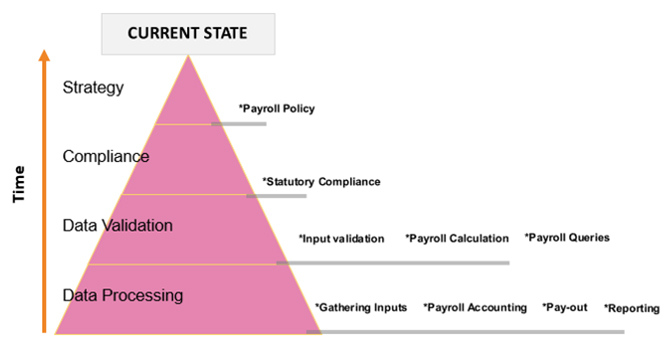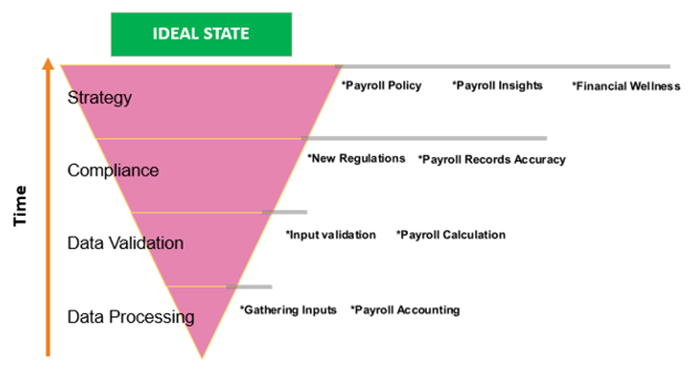Payroll professionals across the globe are tasked with multiple, repetitive, and operational tasks. For some, the lack of flexibility and integration capabilities of legacy platforms, and the complexities involved with processing payroll for multiple countries, increases the time spent in operational activities.
Despite technological advances, payroll has yet to reap its full benefits and, more than that, it begs the question of how payroll professionals may leverage this progress to move up the value chain, thereby contributing to the overall business strategy. In essence, it's time for the payroll function to expand its boundaries to more than processing payroll.
Automated Technologies to the Rescue
With the advent of emerging technologies, most operational activities can be automated to free up a significant amount of time. Next generation payroll solutions engage robotic process automation (RPA) to automate processing of the entire payroll. Built-in artificial intelligence (AI) and machine learning (ML) ensures anomalies are detected and accurately categorized. It is more apt to say that AI and ML bring the much-needed additional layer of intelligence and address challenges around data hygiene, data security, payroll errors, and payroll leakage.
The use of intelligent AI-powered chatbots is not limited to payroll processing. AI allows automating resolution processes for a majority of the payroll-related queries, which significantly reduce payroll processing time and time spent in query resolution. This creates opportunities for payroll professionals to focus on strategic activities that may add significant value for their organization.
Challenges to Overcome
Upon a closer look, there are many challenges that organizations face. These might include geo-political tensions, nimble adjustments organizations make to the global pandemic, use of gig workers, the hybrid workforce, employee well-being, and cost-saving measures. There are multiple variable factors for payroll professionals to consider. Some statistics include the following:
- According to 2022 PwC Employee Financial Wellness Survey, financially-stressed employees are twice as likely to look for jobs elsewhere
- The European Commission recently drafted proposals that would protect gig workers from AI-enabled monitoring
- Gartner survey in 2021 revealed that 32% of organizations are replacing full-time employees with contingent workers as a cost-saving measure
- The IRS collected nearly $7 billion in penalties for 2021 because of payroll errors
- Under the U.S. Fair Labor Standards Act (FLSA), employers that violate the minimum wage or overtime pay requirements are subject to a civil money penalty of up to $1,000 for each such violation
To grow, organizations must keep up with these known, and prepare for unknown, challenges. Can payroll professionals help the organization brave the storm of risks these challenges present? Can payroll professionals move up the value chain from reorienting themselves from the mundane operational tasks to contributing to the business strategy? Yes, they can!
Take a Good Look at Your Function
In order for the payroll department to be seen as a strategic part of an organization, you need to first find answers to several critical questions, which may include the following:
- Is my payroll data compliant with all updated rules and regulations?
- From the data, can I predict if an employee is reaching burnout levels, due to overtime hours, number of direct reports, etc.?
- Is there a wage disparity at certain levels? Can we deploy strategic measures to reduce it?
- Is there something I should do to ensure financial well-being of employees? Does my payroll system offer seamless integration with financial wellness service providers?
- Are there correlations between attrition rate, type of work, schedules, overtime, etc.?
But the real question is—Do they get time to focus on finding answers to these questions?
If we pause here, let’s examine the current state of the payroll pyramid—a hierarchy of activities that payroll professionals are tasked with (see Figure 1).

On average, payroll professionals spend approximately three-fourths of their work time doing repetitive and mundane tasks and approximately one-fourth of their time in strategic tasks. These include gathering inputs for data processing, input validation, payroll calculation and pay-out, and answering a plethora of payroll queries. Payroll professionals spend most of their time on operational tasks.
The irony is that as payroll is a function exposed to a huge chunk of employees’ data—the insights derived from the data can be leveraged in multiple ways that can help devise strategies not just to elevate employee experience but also reduce attrition rates.
Imagine if we invert the payroll pyramid, and let payroll professionals spend 75% of their time in more strategic tasks as shown in Figure 2, such as:
- Driving insights from payroll data for improving efficiency
- Enabling measures to ensure financial well-being of the employees thereby leading to improvement in employee satisfaction and reduction in attrition
- Staying up to date with ever changing laws and regulations to ensure compliance
- Leveraging new age tools and technologies

As we’ve all heard, the only constant is change. There’ll always be challenges, be it the uncertain global economy or regulatory challenges, but now is the time that payroll as a function expands its boundaries and contributes more towards business strategy.
It must leverage the flexibility offered by embracing modern payroll platforms that can intelligently automate repetitive tasks related to payroll processing. It is only then that we can unlock the most undervalued, yet essential, asset of all—human potential.
Find out more about this author in this issue’s Professional Spotlight.